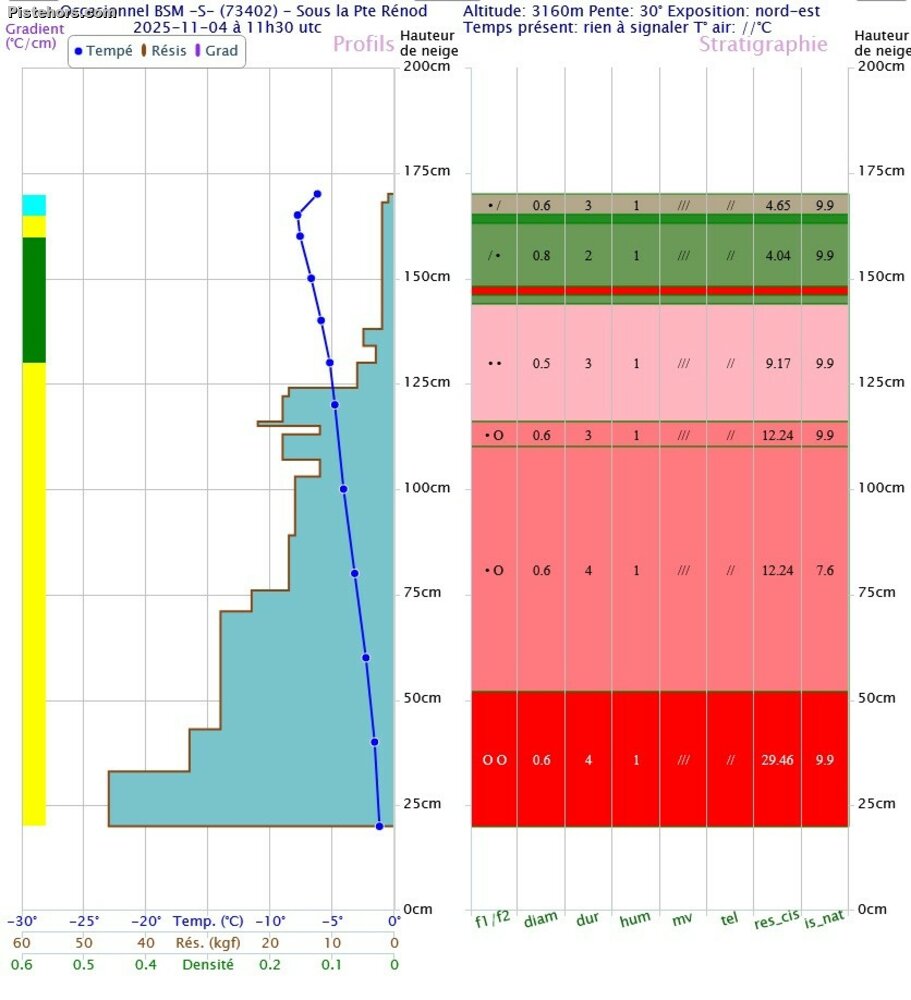The *nivologists* of Météo-France have been back in the field across the Alps, preparing for the start of the 2025/26 avalanche forecasting season. Their early-November reports from both the southern and northern massifs give a first snapshot of the snowpack’s state and the associated avalanche risks.
It was a day of bright sunshine and strong northerly winds (40–60 km/h) for the field team. Access roads were clear, and skiing was possible from around 2060 m, although recent snowplough activity on the Galibier road has compacted much of the snow at lower elevations. Ski conditions were described as *fair*, though the wind has significantly affected the snowpack.
The early-season nivological monitoring began on 3 November, with the avalanche bulletin (BERA) restarting for roughly seven months. Fresh snow from 2 November deposited around 20 cm at altitude. However, strong winds have caused significant transport of this new snow, especially on south to southeast-facing slopes. Small wind slabs and surface cracks were observed, but these remain limited in size and extent. Despite their small size, such slabs could still unbalance a skier in steep terrain.
On sunny slopes, these thin slabs rest on a weak temporary layer composed of lightly winded fresh snow overlying a firmer, refrozen base. With calmer weather and rapid settling, these superficial instabilities are expected to stabilize quickly in the coming days.

In shaded aspects, however, the situation is more complex. A snow profile taken on a N/NE slope at 2785 m (Petit Galibier Ouest) revealed 76 cm of snow with air temperatures around -5°C. Compression tests indicated two distinct weak layers:
In summary, two main problems stand out:
Additionally, a very strong temperature gradient (about 40–45°C/m) was recorded in shaded areas, promoting the formation of faceted crystals. These weak layers pose no immediate risk as long as they remain exposed, but they could become a serious concern once covered by new snowfalls.
Overall, a good start to the season — but one that already calls for vigilance on shaded slopes.
Further north, in the Belleville valley and the Vanoise, conditions were marked by a blue sky, wind on the ridges, and solid snow cover above 2000 m. Skiers could put on their skis from around 2100 m in north-facing slopes and 2400 m on southern slopes. Snow depth ranged from 10–15 cm at lower altitudes to well over a meter on the glaciers.
The snow surface was generally supportive and pleasant to ski, though wind-crusted sections were found near snow cannons and on the Thorens col. On the Chavière and Rénod glaciers, the snow was variable but overall skiable, with particularly good coverage on upper ridges following the heavy, sticky snowfalls of October.
The nivological season has officially started here as well, with daily avalanche bulletins now in effect until mid-June. The snowpack is already deep for the time of year, and a few spontaneous or remotely triggered avalanches were reported the previous day near Ouille Allegra in Haute Maurienne. On the Rénod glacier, only small cracks were observed during stability checks, though caution remains advised on steeper slopes due to some hard slabs.

A snow pit at 3150 m (NE aspect) showed a depth of 1.7 m and surface instabilities detected at CT2@10cm and CT15@30cm, indicating weak temporary layers composed of new snow particles and a few small facets. These are expected to stabilize rapidly in the coming days.
In short: The Northern Alps currently offer excellent early-season coverage above 2000 m, but skiers should remain cautious of wind slabs and isolated weak layers on steep slopes. Conditions are evolving fast — and generally improving — under stable, sunny weather.
In conclusion, both the Southern and Northern Alps are off to a promising start, with solid snow above 2000 m and mainly surface-level instabilities. While the short-term avalanche risk is moderate and decreasing, the development of persistent weak layers in shaded areas deserves close monitoring as the season progresses.
Stay alert, enjoy the sunshine, and have a safe start to the winter!
https://www.facebook.com/share/v/1Bm7VUf1cr/